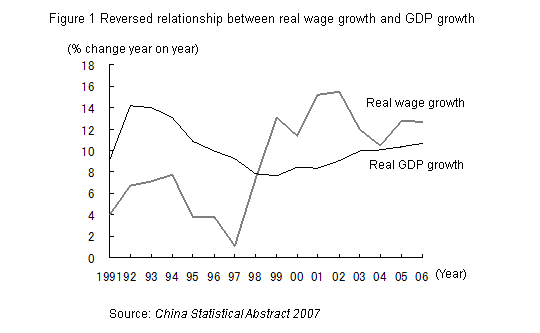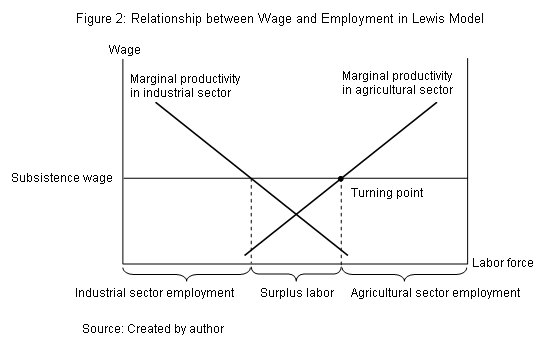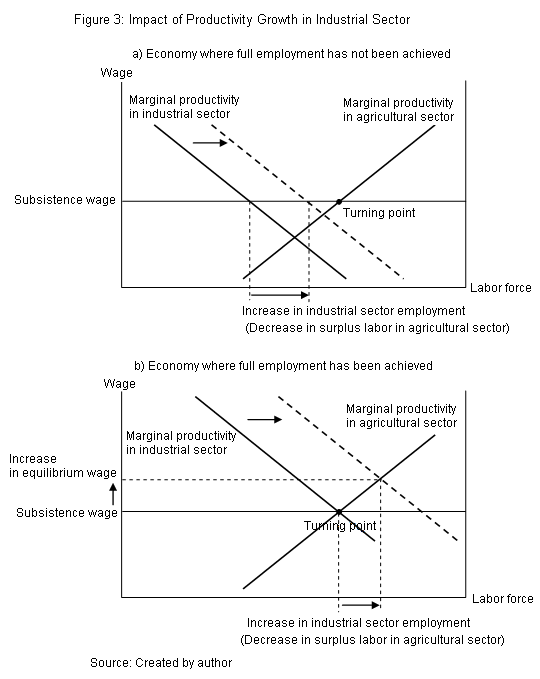The supply of abundant surplus labor from the rural areas to the industrial sector has long been a key support of China's high economic growth rate. In recent years, however, China has fast been moving away from a stage of having a large surplus labor force toward a stage of labor shortage, as symbolized by the tightening supply of migrant workers in the coastal areas. Reflecting this, real wage growth, after years of consistently falling far below gross domestic product (GDP) growth, has been exceeding GDP growth since 1998 (figure 1). The expected realization of full employment may become a constraining factor on China's further growth. At the same time, however, this will contribute to correcting income disparities and upgrading industry.

There are reportedly some 150 million surplus laborers in the rural areas. This figure was cited by the government in its "National Population Development Strategy Research Report" released in January 2007. However, Cai Fang, director of the Institute of Population and Labor Economics, Chinese Academy of Social Sciences (CASS), objects to "surplus labor" hypothesis. He has demonstrated that China will reach a turning point (known as the Lewis turning point, see Addendum below) beyond which labor shortage rather than labor surplus will be the norm as early as 2009(note 1), and his argument has been drawing considerable attention. Against the backdrop of continuing high economic growth and slowing increase in the working-age population as a result of strict implementation of the one-child policy since the early 1980s, Cai says, China's labor demand has been increasing at a more rapid pace than the workforce since 2004, and rural surplus labor will run out completely by around 2009.
A supposedly "unlimited" supply of labor has supported China's growth through a number of channels. First, on the supply side, the fact that surplus labor in the agricultural sector is directly absorbed into the industrial sector contributes to GDP growth. Second, the wage level that is kept stable and low has been advantageous, in terms of income redistribution, to high income earners (those likely to be entitled to capital income), ultimately resulting in high savings and high investment. Third, on the demand side, low wages have enabled China's export-driven economic growth, for which low costs are an overriding factor. The achievement of full employment, however, would change them all. Wages would begin to rise in tandem with an increase in productivity, employment growth would be constrained by the pace of increase in the working age population, the savings rate would fall, and Chinese exports in the area of labor-intensive products would become less competitive in the international market. As a result China's growth rate would go nowhere but down.
The wage increase resulting from higher productivity under full employment, however, has its bright side. First, when the wage level goes up, the share of wages in the national income also increases, resulting in narrowing income disparities. Changes in the supply-demand relationship are already beginning to improve workers' rights not only in terms of wages but also in the form of shorter work hours and less rigorous restrictions under the family registration system. These developments, together with declining unemployment, are expected to contribute to social stability.
A productivity-driven rise in the wage level also results in an increase in the real exchange rate through higher prices under a fixed exchange rate regime or an increase in the nominal exchange rate under a floating exchange rate regime (Balassa-Samuelson hypothesis). An appreciation of the renminbi (RMB) would increase the purchasing power of Chinese consumers through improved terms of trade (relative prices of exports to imports), contributing to an expansion of domestic demand and a reduction in the external imbalance.
Furthermore, as in 1960s Japan, changes in relative prices, while hampering the international competitiveness of labor-intensive industries, can become - through companies' efforts to overcome such difficulty - a factor contributing to advanced industrial structure and improved productivity. If realized, this halts the declining economic growth rate. Indeed, Japan's high growth of about 10% continued into the 1970s even though the country is thought to have achieved full employment as early as around 1960.
Lastly, although the Chinese government has been cautious about RMB revaluation due to concern over negative impacts on employment, achieving full employment would eliminate the need for such concerns. The government would adopt a more positive stance toward RMB revaluation due partly to the need to control inflationary pressure resulting from wage increases.
Addendum: What is the Lewis turning point?
In analyzing economic development in a dual economy such as China with two separate economic systems, the traditional agricultural sector and modern industrial sector, the model developed by and named after economist W. Arthur Lewis (1915-1990) is effective. According to this model, many developing countries have a virtually unlimited supply of labor for the industrial sector because of the massive labor surplus in rural areas. While wages are kept at a minimum, just enough for workers to survive, the volume of employment in the industrial and agricultural sector is determined by the point at which marginal productivity equals the level of wages in the respective sectors (figure 2). In this kind of economy, where full employment has yet to be achieved, productivity improvement in the industrial sector, achieved either by attracting foreign investment or through other means, expands employment (in the industrial sector as well as in the whole economy) by absorbing surplus labor in the agricultural workforce and without causing any wage increase (figure 3 a)). In contrast, once that economy has surpassed the Lewis turning point, at which full employment is achieved, the industrial sector needs to raise wages in order to secure workers by reducing those in the agricultural sector, and the overall volume of employment remains unchanged (figure 3 b)).




